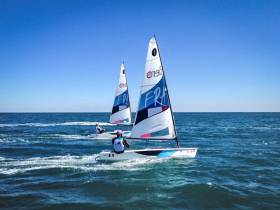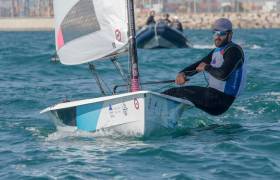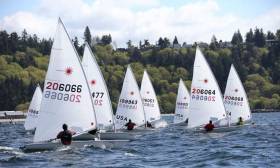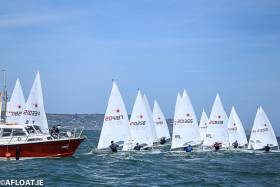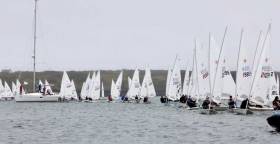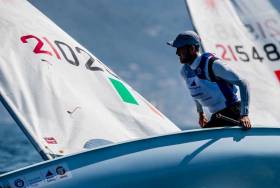Displaying items by tag: Laser
RS Sailing says it respects the World Sailing council vote to retain the Laser as the Men’s and Women’s One Person Dinghy event for the 2024 Olympic Games in Paris — while also hailing the RS Aero’s superior evaluation.
As reported yesterday on Afloat.ie, sailing’s world governing body voted in a secret ballot on the last day of its Mid-Year Meeting on Sunday 19 May to retain the Laser and Laser Radial.
This was despite the upstart RS Aero outscoring the incumbent — which faces a name change amid a dispute between the class association and its former leading manufacturer — by more than 10% in a detailed evaluation and sea trials conducted this past March.
Reflecting on the decision taken in London on Sunday, RS Sailing said it “would like to sincerely thank World Sailing for giving the RS Aero the opportunity to be part of the 2024 Equipment Selection for the Men’s and Women’s One Person Dinghy.
“We were impressed throughout the whole process by the Evaluation Team, World Sailing staff and the Equipment Committee who did a very professional and impressive job. We were extremely confident in the depth and thoroughness of the Evaluation Panel to conduct a fair and complete evaluation process.
“RS Sailing also sends a heartfelt thank you to all our followers and sailors, old and new, and have been completely overwhelmed by the global support for the RS Aero and RS Sailing. You’ve all genuinely been on this journey with us and it feels like we’ve made a whole load of new friends in the process.”
The UK company said it was “undeniable that the RS Aero has been proven superior in almost every aspect” and cited comments from Dina Kowalyshyn, chair of the World Sailing Equipment Committee, who noted the boat’s light hull and size (which “make it attractive and suitable for the youth pathway”), its “modern materials and modern production methods”, and the fact that it is “mass production ready”.
“We couldn’t be prouder of the RS Aero,” RS Sailing added. “We have known for a long time that it was an awesome boat to sail but it’s now proved itself irrefutably to the world that it is.”
The company said it understands there are issues beyond determining what is the best performing equipment when it comes to the selection process.
“When the world is so heavily invested in legacy equipment it’s hard to move on from it,” it said, adding that it will continue to encourage World Sailing council members and member associations “who are eager for change from heavier, 50-year-old design equipment”.
RS Sailing continued: “We still believe that these decisions are not just about the Olympians; this universal sector drives the youth pathways and the opportunity to build women’s participation as well.
“The sport is currently in decline in many regions and we all share the primary responsibility to reverse that trend by proactively working with sailors and MNAs using the most modern equipment to present sailing to the widest possible audience in a collaborative and sustainable way.”
Despite coming second in a comprehensive evaluation established by World Sailing, the governing body's top-level Council has retained the Laser dinghy as the equipment for the men and women's single-handed dinghy in the 2024 Olympics. Yesterday's (19th May 2019) World Sailing Council decision ignores the recommendation of the equipment committee and the evaluation panel to change the equipment to the RS Aero which had outscored the Laser 80% to 69% in the detailed evaluation and sea trials conducted in March 2019.
The evaluation panel, which included members from the Re-evaluation Working Party, the Equipment Committee, the Events Committee, the Emerging Nations Programme, the Medical Commission, Athletes Commission, World Sailing’s Technical and Offshore team and World Sailing Board members, assessed five boats in the areas of performance, athletic suitability, appeal, quality of production, standardization of the equipment, cost, distribution capacity, universality considerations and suitability.
The World Sailing Council were also aware of the recent removal of Laser Performance Europe (LPE) as a licensed builder. The dispute between the International Laser Class (ILCA) and LPE has resulted in a proposal to change the name of the boat to "ILCA Dinghy". ILCA says that the licensed builders in Australia and Japan will now supply the European market. The Australian Builder, Performance Sailcraft Australia (PSA), seems to have resolved its own difficulties with ILCA, who, in 2015, had issued a "defect notice" to PSA over an additional layer of chopped strand mat found in PSA boats.
The vote by Council in favour of the Laser/ILCA Dinghy may not be the end of the process. Council decisions have to be ratified by the member National Authorities (MNAs) at the AGM in November. And while the response by LPE to the ILCA withdrawal of their construction rights has, to date, been only through statements, a legal challenge cannot be ruled out.
The decision making process itself is under review by a Governance Commission which has recommended sweeping changes to the current World Sailing Structure, perceived to be outdated and biased towards the larger first world MNAs.
As Afloat reported earlier, other decisions by World Sailing Council included the ratification of the 470 as a mixed two person dinghy, a foregone conclusion as no other boat was offered as an alternative. On the Offshore side, a list of approved boats will be published in December 2020 from which the 2024 boat will be chosen no later than 31 December 2023.
World Sailing’s Council made key decisions on the Equipment to be used at the Paris 2024 Olympic Sailing Competition on Sunday 19 May as the Mid-Year Meeting concluded in London, Great Britain.
The Laser was selected as the Men’s and Women’s One Person Dinghy, the IKA Formula Kite as the Mixed Kiteboard and the 470 as the Mixed Two Person Dinghy.
A Board of Directors recommendation to select the RS:X as the Men’s and Women’s Windsurf Equipment was rejected meaning a new proposal will be required and the process on selecting the Equipment for the Mixed Two Person Offshore Keelboat was also confirmed.
Paris 2024 Equipment
Before Council made its decisions on the Paris 2024 Equipment, the Board of Directors updated Council on its current plans for the Olympic Classes Contract. This included the position on implementing World Sailing’s Olympic Equipment Strategy (FRAND) agreed by Council in November 2018. In order to provide certainty for MNAs, sailors and teams, the Board will engage in contractual discussions only until 1 August 2019. If by that time no agreement is reached, the Board will report to Council that no agreement has been concluded and Council will then have to select new Equipment for the relevant Event.
Ahead of the debate, 21 Council members voted in favour of all votes on the Olympic Equipment being held in secret with 20 against. As a result, every vote cast was secret.
Men’s and Women’s One Person Dinghy
The Laser was selected as the Paris 2024 Men’s and Women’s One Person Dinghy Equipment, subject to agreement of the Olympic Classes Contract for 2024, following a ballot vote.
Under Regulation 21.1.3 (e), the decision on selecting the Equipment has to be made before 31 December 2019. Council members voted on deferring the selection of the Equipment to the 2019 Annual Conference but this was rejected meaning a decision had to be made in London.
The next step was to vote on the Equipment Committee recommendation to select the RS Aero. Their recommendation was rejected.
The process moved to a ballot and Council members were able to vote on the four boats that were part of the process – the D-Zero, Laser, Melges 14 and RS Aero.
The Laser won in the first round of votes.
For the Men’s One Person Dinghy, 36 voted for the Laser and five voted for the RS Aero. The D-Zero and Melges 14 received zero votes and there was one abstention.
For the Women’s One Person Dinghy, 37 voted for the Laser and four voted for the RS Aero. The D-Zero and Melges 14 received zero votes and there was one abstention.
Men’s and Women’s Windsurfer
As the Men’s and Women’s Windsurfer Equipment is under a re-evaluation procedure, World Sailing’s Board of Directors have authority on making recommendations to World Sailing’s Council.
The Board of Directors recommendation was to select the RS:X as the Equipment. 19 Council members voted to accept the recommendation, 23 voted to reject and there were zero abstentions.
As a result, the recommendation was rejected.
The Board of Directors will now have to propose a new recommendation to the Council.
Mixed Kiteboard
The Equipment Committee recommended to Council that they should approve the IKA Formula Kite Class as the Equipment for the Mixed Kiteboard Event. Forty Council members voted to approve the recommendation subject to agreement of the Olympic Classes Contract for 2024. One member rejected and one abstained.
Mixed Two Person Dinghy
World Sailing’s Council approved the 470, subject to agreement of the Olympic Classes Contract for 2024, as the Equipment for the Mixed Two Person Dinghy following the recommendation from the Equipment Committee. 41 members voted in favour of the 470. One member was against the 470 and there were zero abstentions.
Mixed Two Person Offshore Keelboat
Submission M01-19, which proposed a way forward with the procedure for selecting the Equipment, was put forward by the Board of Directors in advance of the Mid-Year Meeting and was approved by Council. 39 members were in favour with two rejecting and zero abstentions.
The Submission proposed that World Sailing's Council shall select a list of different Equipment which it considers to meet the key criteria of the event by 31 December 2019 and then make a decision on the Equipment, selecting from the list no later than 31 December 2023.
The Board agreed to amend the date to meet the key criteria of the event from 31 December 2019 to 31 December 2020 which Council approved.
MNAs, Classes and Manufacturers will now be invited to propose Equipment for the list. A Working Party with members from the Equipment Committee, Offshore Committee and Events Committee will evaluate the Equipment against the key criteria and present the recommended list for Council approval in November 2020.
The list will provide event organisers, MNAs and sailors with diverse opportunities to train and compete in Equipment that is tested, readily available and affordable in their continent. Postponing the decision of the Equipment that will be supplied at the Paris 2024 Olympic Sailing Competition will also promote fair opportunities for all MNAs.
Any changes to the Regulations that Council makes must also be ratified by our Annual General Meeting in November.
Governance Reform Presentation
The Independent Chair of the Governance Commission, Maria Clarke, a sports lawyer and sports governance expert, presented the Board of Directors Proposal for wholesale governance reform of World Sailing.
The Proposal was prepared by World Sailing's Governance Commission after more than a year of consultation, feedback and research with Member National Authorities (MNAs), Class Associations, Council, committee and commission members and the wider sailing community.
Click here for the Proposal - http://www.sailing.org/news/88596.php#.XOF9BaZ7m_W.
Clarke took Council delegates through the proposed reforms and highlighted the need for Council members and World Sailing’s stakeholders to provide further feedback as part of the consultation process.
Following a review of that feedback, the Commission will adjust the Proposal as necessary and make its final recommendations to the World Sailing Board, which, if approved, will then prepare and finalise a whole new Constitution for voting on. This is expected to occur at the Annual General Meeting in November 2019.
Events Strategy
Alastair Fox, Director of Events, and Sarah Kenny, Chair of the Events Committee, presented an Events Strategy Working Party report on World Sailing's opportunity to develop a new strategy for 2021 - 2028.
The strategy focused on the requirements for sailors and that it must add value for all of World Sailing's stakeholders with the Olympic Games at its heart.
Three key goals were established to promote sailors progression with a clear regatta structure, ensure a stable regatta calendar with a credible ranking system and to see that Olympic level sailing is promoted to a greater audience to drive participation.
On Thursday 17 May, the Events Committee endorsed the principles of the paper providing similar levels of World Sailing support were provided to class events, that a definition of, and how to become, a top-ranked regatta is established and how to make the events sustainable and cost efficient.
World Sailing’s Council approved the Strategy and work will now commence to implement.
The next meeting of World Sailing will be the 2019 Annual Conference. Bermuda will play host to delegates from 26 October to 3 November 2019.
RS Sailing has issued an open letter to World Sailing in its bid for the men’s and women’s Olympic single-handed dinghy classes currently appointed to the Laser and Laser Radial.
Late last year the RS Aero was selected along with the incumbent Lasers, the Melges 14 and D-Zero from a total of eight bidders for equipment trials for the 2024 Olympic Games in Paris.
More recently, each of these boats (the incumbents excluded) were evaluated in sea trials for men and women in Valencia, Spain in March of this year.
Further trials will be conducted before a final decision is made by December 2020.
But the directors of UK-based RS Sailing — design and tech chief Alex Southon, commercial chief Jon Partridge, sales director Riki Hooker and c-founded Martin Wadhams — are already making their appeal to World Sailing and its member national associations to see the RS Aero as the future of single-handed dinghy sailing at the Olympics.
The full letter is included below:
Dear Mr President and all,
In the coming days World Sailing will make decisions that are likely to affect our sport for the next couple of decades and we feel it appropriate to share our views.
Over the last twenty‐five years we have created RS Sailing and built it into the world’s leading small sailboat brand. We have changed the face of small boat sailing in many parts of the globe, we have made friends on every continent and shared beers in many sailing clubs. We are proud of RS Sailing’s achievements, made not by a few people but by many sailors who believe our sport can be better.
We have not got everything right, but we have listened to the sailors and done our best to create boats and events that are right for the future of our sport. That is why we’re now the brand leader.
We always knew the decision regarding the Olympic single‐hander would be highly charged and the odds are stacked in favour of the incumbent. But the coming decisions are not just about the Olympians; this universal sector drives the youth pathways and the opportunity to build women’s participation as well. The sport is currently in decline in many regions and we all share the primary responsibility to reverse that trend.
The Evaluation was clear. Detractors will always find details to argue but the fact remains the people involved were unanimous in their view that the RS Aero offers clearly the best opportunity – for the youths, women and Olympians.
The boat is ultra‐light, dynamic and better suited to working with a range of rig sizes for light to heavy sailors. It uses high tech construction for competitive longevity. It is backed by the RS organisation, seen as the most capable of delivering consistent high quality to the world through our existing infrastructure and an international FRAND production network on every continent.
Look what happened to cycling when the equipment became light and sexy – the sport exploded.
Conversely, the current Equipment design is fifty years old and heavy. Whatever the rigs, the hull is heavier than many of the sailors it seeks to serve… Lift your bike, ride your bike and think about it...
The issues between the various organisations that build and manage the current Equipment are well documented and long running. They make life harder for many sailors and organisers. Recent communications make it clear that solutions have not been agreed. The issues and potential for litigation against all parties involved distract from growing our sport and threaten World Sailing’s reputation – indeed sailing’s reputation within the Olympic movement.
So, over to you World Sailing. The experts you selected have told you that the RS Aero is the best Equipment for the future of sailing and we have proved ourselves credible partners. The current Equipment was second ranked, even without factoring in ongoing commercial issues.
You can select new Equipment; you can simply ignore the information laid out by the experts and make no change; or you can take some time to consider what is best for the direction of our sport. A smooth transition is possible – perhaps starting with the women’s fleet or the youth pathway.
We offer you a chance to inspire the next generation.
We offer the RS Aero.
Yours,
Alex, Jon, Riki and Martin
Last weekend saw the running of the increasingly popular Investwise and CH Marine sponsored Irish Laser Masters National Championships, which took place at Howth Yacht Club, a stunning setting for the event. The event has been running since 1982, where the first Nationals was held in Dunmore East. Most notable this year was the significant increase in the Radial Fleet. A fleet of 40 boats split between Radial and Standard Rigs competed. All sailors in the Masters Fleet are 35 years of age or older. The Radials consisted of all visitors bar one as the host club has no real Master Radial fleet yet. However, with local adult Radial fleets on the increase up and down the country, next year should see in excess of twenty Radials at this event.
 Laser Masters racing at Howth
Laser Masters racing at Howth
The fleet was greeted by superb Howth weather; sunshine, blue skies, breeze and even some white horses. The race course was set up promptly and racing was underway as scheduled- the radials being particularly well behaved on each start line! There was great racing throughout the fleet on both days in the varying conditions.
Remember the fable about the Hare and the Tortoise…. Well, that was the story of first race in the Standard Fleet! The Hare was the whole fleet of Laser Sheep who missed the last mark and the Tortoise was one experienced Joe Cull – Laser Grandmaster – who probably recorded one of the biggest winning margins, before the rest of the Laser sheep realised their mistake! Grandmaster trophy sealed by 70-year-old Joe Cull in one move!
Racing was extremely tight in the Standard Rig fleet with up to 8 boats overlapped at leeward marks vying for the lead. After 3 races in mixed and testing conditions on the first day, Nick Walsh [Cork] lead the fleet. The very competitive on the water racing had 3 different race winners and 6 Laser masters still within reach of the title, at the end of day one.
"In the Radial fleet, three different race winners on Saturday set the scene for competitive racing"
In the Radial Fleet, three different race winners on Saturday set the scene for competitive racing with Darrell Reamsbottom and Conor Clancy taking race wins after Sean Craig took the opener. Difficult conditions ensued as the breeze eased throughout the day leaving an unpleasant chop. Judy O’Beirne laid down a marker for the keenly contested Ladies award with a good 5th in race 3. Peter Hassett performed well this weekend with all top 4 results and might have been second except for some pilot error in race 2!
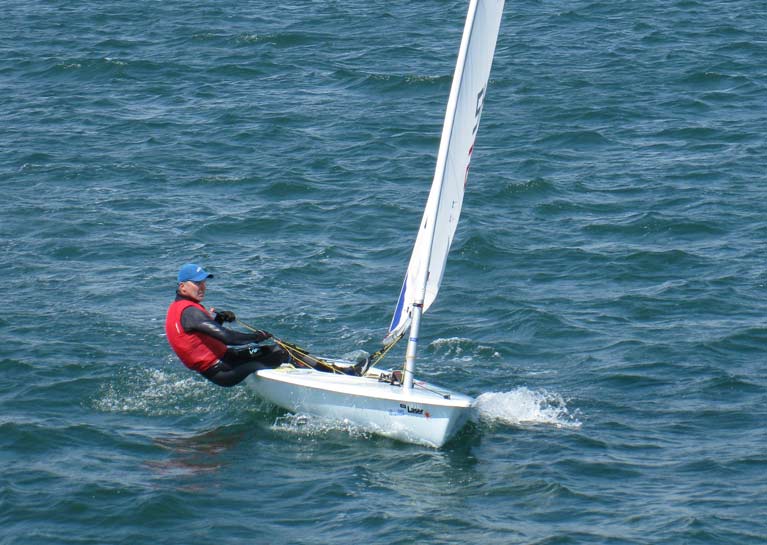 Radial Fleet winner, Sean Craig
Radial Fleet winner, Sean Craig
Back on shore the social side kicked off in good spirits. After all, the Masters is much more than just sailing! Some thirsty sailors gathered for an Investwise sponsored Hope beer drinks reception and racing debrief given by Ronan Wallace. Onboard trackers were used, showcasing our gains and losses (even one capsize!) with much slagging between the Standard rigs and Radials, but especially highlighting Standard Rigs missing the black mark in race 1! This was followed by a delicious meal in the magnificent setting of HYC dining room with the rugby on a large screen.
Sunday provided more wind than expected, with 15-20kts on the race course, enough to cause a few aches and pains by the evening! Here the Radial rig really came into its own! Two good hard races and Sean Craig and Marco Sorgassi had a ding-dong up-front before Craig pulled away in each. Craig only had a two point margin from Reamsbottom on three best results going into the final race and was keeping a very close eye on him, especially with that local knowledge. Sean Flanagan had a better second day showing the Grand Masters (Over 55s) can still do it! Philip Doherty from Cork came through well in the stronger conditions also.
Craig retained his title from 2018 showing his superior speed in true style with a very tight finish for 2nd, 3rd and 4th with Reamsbottom next, then Sorgassi, just edging out the unlucky Clancy. In the Ladies, Judy O’Beirne took the laurels showing her Frostbiting and recent training have paid off. Flanagan took first Grand Master.
In the Standard Rig, great consistency paid for David Quinn [Howth] as he sealed the title, counting 3 2nds and a 3rd, in some very close racing. With positions changing nearly every leg in the final two races he used his local knowledge and showed great ability along with experience to come out on top. Nick Walsh settled for 2nd and Dan O’Connell [Dun Laoghaire] hiked his way into 3rd overall.
Let’s just say the unnamed ‘Lead Hare’ continued his form [he got the 2 bullets in the last 2 races!] and used his local knowledge to sail onto the sandbank on the way back home…. At least most of the sheep learned and didn’t follow this time…!!!
Thanks to the excellent Race Officer, Harry Gallagher and his team of mark layers, Jim McMahon who ran launching and recovery on the slipway, the sponsors, Investwise and CH Marine, and finally to Dave Quinn for organising a superb event with great attention to detail.
Report by Shirley Gilmore and Ross O'Leary
 Dan O'Connell, 3rd Standard Rig (left) with HYC Commodore Ian Byrne
Dan O'Connell, 3rd Standard Rig (left) with HYC Commodore Ian Byrne
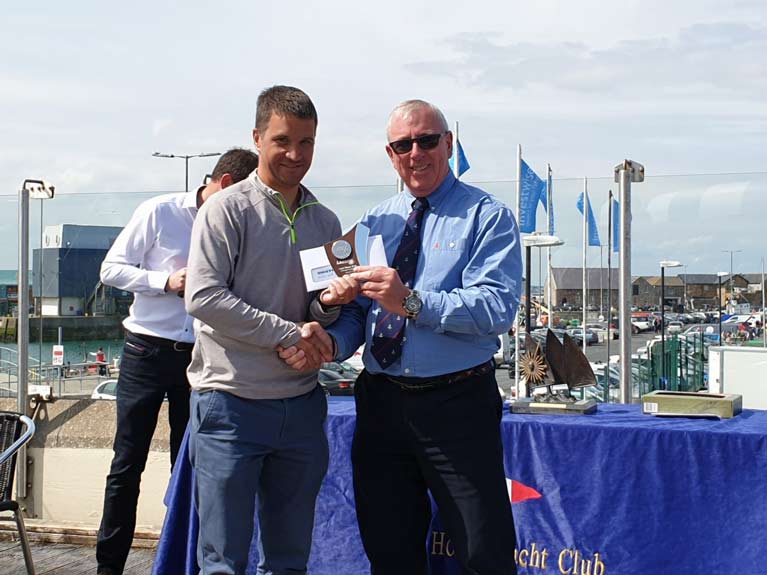 Darrell Reasmbottom 2nd Radial
Darrell Reasmbottom 2nd Radial
 Joe Cull Grand Master Standard Rig Winner
Joe Cull Grand Master Standard Rig Winner
 Marco Sorgassi, 3rd Radial
Marco Sorgassi, 3rd Radial
 Sean Flanagan, 1st Grand Master, Radial Fleet
Sean Flanagan, 1st Grand Master, Radial Fleet
 Sean Craig, Winner Radial Fleet
Sean Craig, Winner Radial Fleet
 Dave Quinn with the Standard Trophy
Dave Quinn with the Standard Trophy
Footnote:
Irish Laser Masters is probably one of the fastest growing fleets that provide a great standard of racing for all levels and abilities from 35 years +. Family friendly it is a great way to get on the water, try to stay fit and enjoy your sailing with this very sociable bunch… most sailing clubs have a local fleet and the ILA are providing training support if you want to grow the fleet in your area for all ages and abilities…more information contact [email protected]
Ireland’s Classic Sailing Boats are Ageless
At a time when we’re constantly being warned in public life that we have to mark the current “Era of Centenaries” in a sensitive manner, it’s probably insensitive to respond by pointing out that the Irish sailing community is having quite enough trouble, thank you, in getting used to the fact that some boats we still think of as being modern are actually entering the vintage category and beyond writes W M Nixon.
But that’s the way it is. Perhaps “ageless” is not the word we seek. Maybe we should be veering more towards the all-enveloping category of “timeless”. Whatever it is, there are many among us who simply can’t get our heads around the fact that the always-elegant International Dragon is 90 years old in 2019, while the ever-young, fresh-as-a-daisy Laser is having her Golden Jubilee.
Laser Class Golden Jubilee
Or maybe it will be next year – it all depends on how closely things followed on from the ground-breaking Laser-creating phone call in 1969 (or even earlier) between Canadian boat ideas man Ian Bruce, and fellow-Canadian designer Bruce Kirby, aimed at providing an inexpensive easily-carried single-hander which looked good and sailed well.
The boat as she emerged – finally christened the Laser in December 1970 – closely followed Kirby’s original doodle in the immortal style of the best inventions. And of course, she has become one of the few boats to acquire Olympic status (it was in 1996) while remaining genuinely and hugely popular at club level.
We’re well aware that some global Laser production had been going through such a sticky patch recently that we’re now meant to call the officially-recognised boat the “ILCA Dinghy”. But it’s going to take some doing to get a re-naming to stick in place for a boat with the Laser’s long-standing popularity and brand recognition.
This popularity was very clear at last September’s Laser World Masters in Dun Laoghaire, with more than three hundred sailors from all over the globe, and Ireland getting a star performance from Mark Lyttle of the National Yacht Club. A turnout on this scale really was something else – there were Lasers in abundance whichever way you looked, and more than a few of the helms far out-dated the design concept of their wonderful little boats.
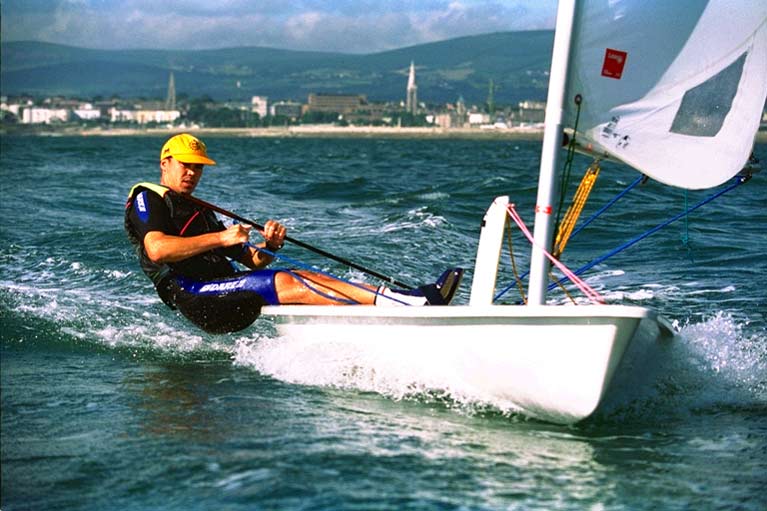 Mark Lyttle (NYC) training in Dublin Bay for the first Olympics with the Laser in 1996, when he was a race winner. Photo: David O’Brien/Afloat.ie
Mark Lyttle (NYC) training in Dublin Bay for the first Olympics with the Laser in 1996, when he was a race winner. Photo: David O’Brien/Afloat.ie Mark Lyttle after winning the Grand Masters Division in the Laser Worlds in Dublin Bay in September 2018. Photo: David O’Brien/Afloat.ie
Mark Lyttle after winning the Grand Masters Division in the Laser Worlds in Dublin Bay in September 2018. Photo: David O’Brien/Afloat.ie
But equally, as the “Masters” categories begin at age 35, there were quite a few helms who had yet to make their debut on the planet when the Laser was already born, so the vintage overall nature of the boat could well match the impressive range of maturity of some of the most senior helms.
This will be in evidence at the Irish Laser Masters this weekend in Howth, where they’ve had a continuous Laser racing programme on the go since 1974. But though Howth’s annual frostbite series for this timeless little boat continue to attract a healthy turnout, as is so often the case the sheer population weighting to be found south of the Liffey means that Dun Laoghaire names pack numbers and success, and defending champion in the Radials is RStGYC’s Sean Craig, who expects strong competition from clubmate Marco Sorgassi, while the home club’s Dan O’Connell, Dave Quinn and Daragh Kelleher are in winning form.
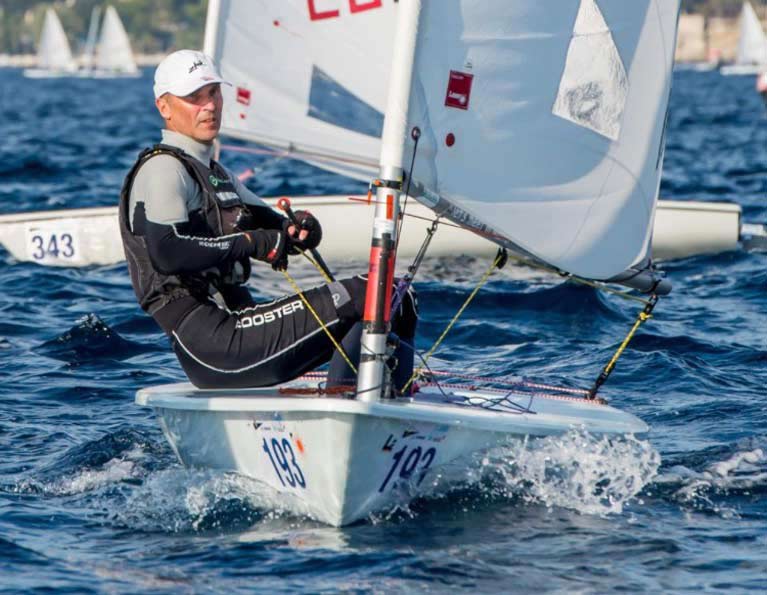 Sean Craig, defending champion in the Radials this weekend’s Irish Laser Masters at Howth
Sean Craig, defending champion in the Radials this weekend’s Irish Laser Masters at Howth
These are all sailors to whom the adjective “timeless” could equally apply - living embodiments of the saying that sailing is a sport for youth of all ages. And even if the Laser does get replaced in the Olympic stakes by some newer design – as has been hinted for the French Olympics in 2024 – we only need to look at the story of the International Dragon to realize that Laser sailors will continue to have their sweet little boats as designed by Bruce Kirby playing a very big part of their life afloat well into the foreseeable future and beyond.
Because once upon a time, the International Dragon was very much a part of the Olympic circus. So much so, in fact, that when she got her marching orders after the 1972 Olympics - having been in the lineup since 1948 – there were those who thought it would lead to an inevitable decline in the class.
Dragon Class is Ninety Years Old
But on the contrary, it seems that most Dragon sailor cared a lot more about the joy they got from their boats than they did about the Olympic thing. So much so, in fact, that today the class is facing into year 90 in the very best of health, and its big championship, the 2019 Yanmar Dragon Gold Cup at Medemblik in the Netherlands from the 8th to 14th June, has already attracted more than a hundred boats from 16 nations in four continents, with Jorgen Schonherr from Denmark the defender after the championship in Finland last year.
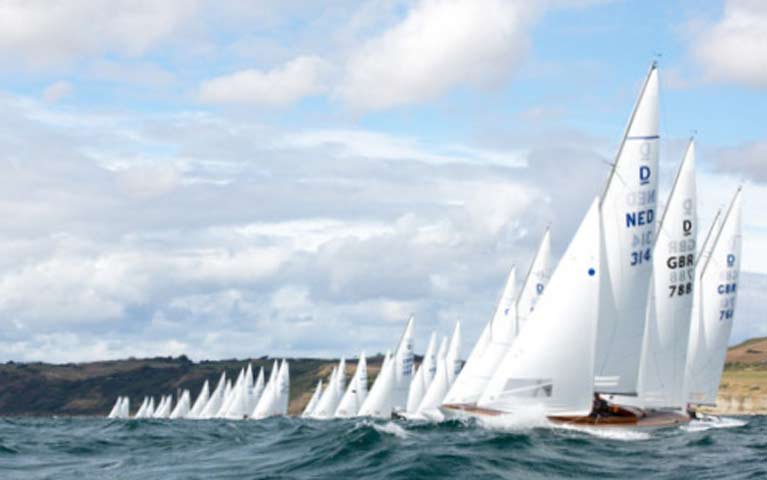 So who needs to be an Olympic class? The Dragon Gold Cup ten years ago. The 2019 event in The Netherlands in June has already attracted more than a hundred entries from sixteen countries.
So who needs to be an Olympic class? The Dragon Gold Cup ten years ago. The 2019 event in The Netherlands in June has already attracted more than a hundred entries from sixteen countries.
The Dragon first appeared in Sweden in 1929 to a design by Norwegian Johan Anker, and there has been Irish involvement in the class since at least 1936. Certainly what is probably the most senior Dragon still racing – Don Street’s Gypsy in Glandore – is all of 86 years old, and she has been in Ireland a long time. As for her extraordinary skipper, he is one of the keenest advocates of the Dragon as a boat for sailors of all ages even if he himself is 89, but he concedes in the Dragon-sailing longevity stakes to Australia’s champion Gordon Ingate, who this year will be 92.
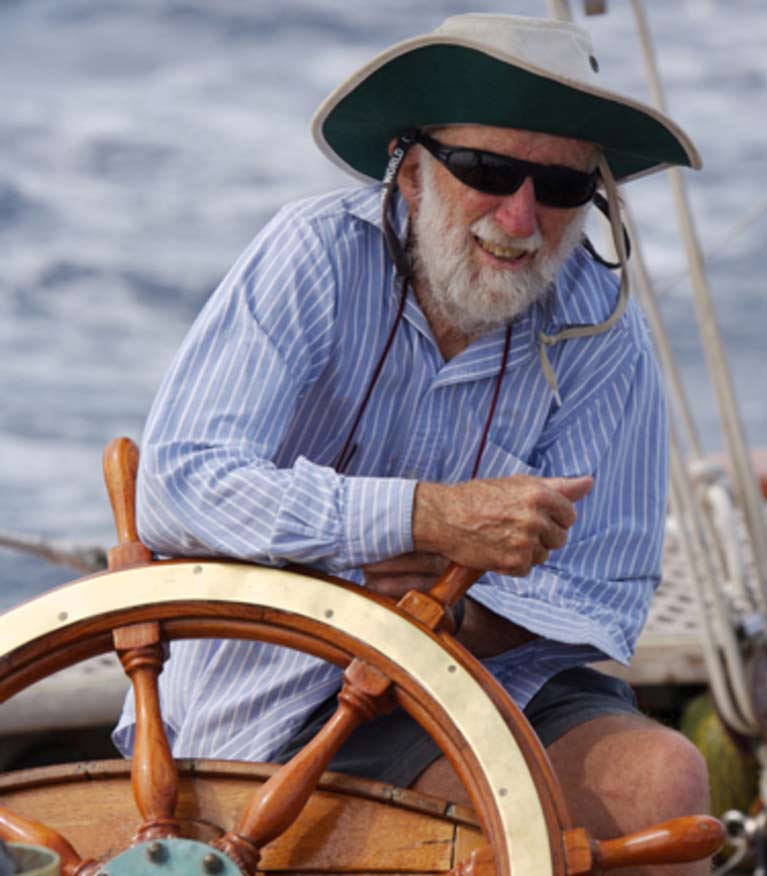 The legendary Don Street – at 89, he races an 86-year-old Dragon with as much enthusiasm as ever
The legendary Don Street – at 89, he races an 86-year-old Dragon with as much enthusiasm as ever
These figures are enough to make anyone dizzy, so to get some idea of the Dragon’s enduring appeal, let’s consider Irish involvement with the Gold Cup, which dates back to 1936. On several occasions, we’ve had a top Irish boat there or thereabouts, but the harsh reality if that it was brought back to Ireland only the once, and it was to Northern Ireland, to the then-thriving Dragon fleet at RNIYC at Cultra on Belfast Lough.
It was 1947, and the winner when the Gold Cup was raced on the Firth of Clyde was Eric Strain of RNIYC helming Billy Barnett’s Ceres. This led in due course to Strain becoming the British Dragon Helm in the 1948 Olympics at Torquay. But as Ceres was just a standard Scandinavian-built Dragon, Billy Barnett – who owned a successful Belfast engineering firm – decided that the exceptional talent of Eric Strain deserved the very best boat that money could buy, so the legendary yacht-building firm of Camper & Nicholson in Gosport were commissioned for the job.
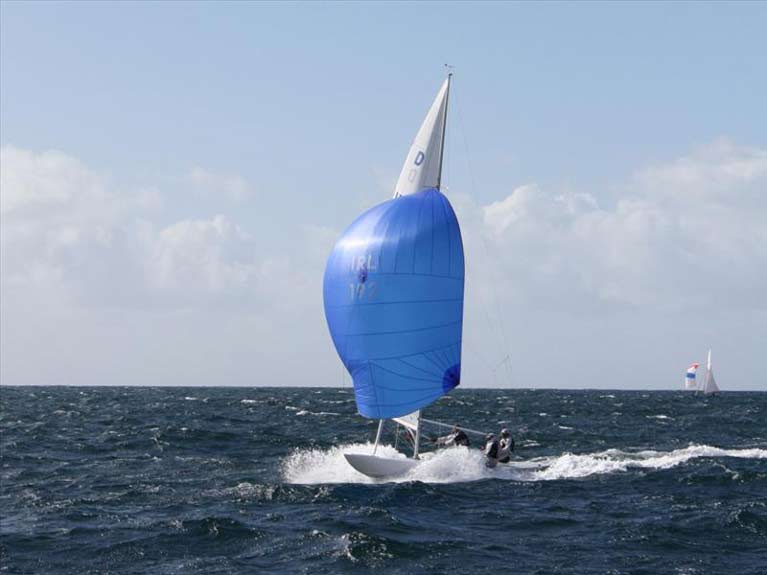 Offshore at Glandore, the Dragons can get up and fly…Photo: GHYC/Richard Harrison
Offshore at Glandore, the Dragons can get up and fly…Photo: GHYC/Richard Harrison
The resulting Ceres II was an exquisite bit of work. Maybe too exquisite. It was suspected that she was slightly heavier and not as fast as the first Ceres, and at the 1948 Olympiad, while Eric Strain and Ceres II did well, it wasn’t quite good enough. They were fourth. In Ireland, we do not need to be reminded of the huge void – a veritable chasm - to be found between the Bronze Medal-winning third and the otherwise commendable but medal-less fourth…….
1948 is now 71 years ago, yet today the International Dragon continues to play a very special role in world sailing. It’s something we take for granted. But what other sport would be continuing to use equipment designs whose unchanged basic concept originated 90 years ago? Boats which - to many of us - still seem well up-to-date.
Historic Ketch Ilen
It brings us back to that concept of timelessness. This weekend, the Limerick ketch Ilen will be on passage from Dunmore East towards Dublin Bay, and when people get to see her at Poolbeg from Sunday evening, and at the Royal Irish YC in Dun Laoghaire next Friday, they’ll be in no doubt that they’re looking at a concept of considerable antiquity, as her design of 1926 was evolved from Conor O’Brien’s Saoirse design of 1923, which O’Brien said was in turn inspired to some extent by a notably able Arklow fishing boat which dated from the 1860s.
Whatever the origins, it means that Ilen is only three years older than the International Dragon, and that the Laser has been around for more than half of Ilen’s existence. Truly, ours is one extraordinary sport. And if you really want to point up the oddities of vehicle design which sailing can produce, just consider that some years ago the berth at the RIYC which Ilen will occupy was very elegantly filled by the 70ft Fife designed-and-built cutter Hallowe’en.
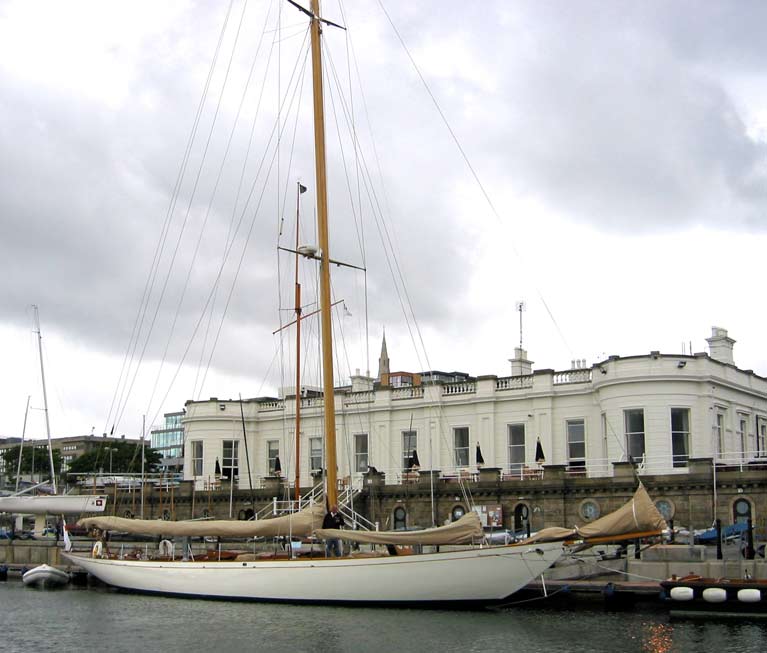 A Fastnet Race record setter, the 70ft Fife cutter Hallowe’en (seen here at the RIYC in Dun Laoghaire) was built in 1926. Photo: W M Nixon
A Fastnet Race record setter, the 70ft Fife cutter Hallowe’en (seen here at the RIYC in Dun Laoghaire) was built in 1926. Photo: W M Nixon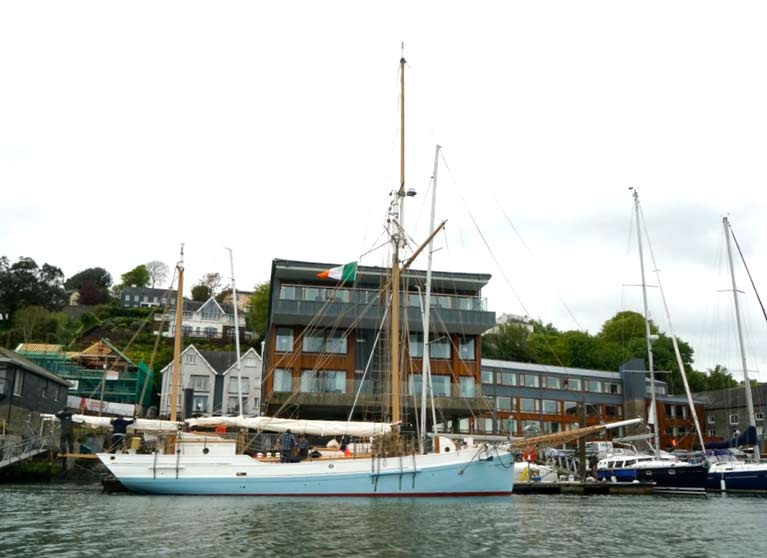 The 56ft Ilen – seen here in Kinsale this week – was also built in 1926. Photo: Gary MacMahon
The 56ft Ilen – seen here in Kinsale this week – was also built in 1926. Photo: Gary MacMahon
Hallowe’en was built in 1926, and she took line honours in that year’s Fastnet Race in a record time which stood for many years. It’s mind-boggling to think that in the same year – and in a boatyard at Baltimore near the Fastnet Rock itself – the unbelievably different Ilen took shape. Yet such is the case, and next Friday we’ll have the opportunity to savour the variety of sailing craft which the special calls of seafaring can produce - and each and every one of them has their devoted adherents.
Eve McMahon Wins First Race of Europa Cup on Lake Garda
Irish Radial Girl youth sailing champion Eve McMahon continued her top form by winning the first race of the Laser Europa Cup on Lake Garda, Italy yesterday.
Howth Yacht Club's McMahon, who is aiming to represent Ireland this July at the World Sailing Youth worlds is part of the Irish Sailing Academy team competing, along with brother Jamie (pictured above), Tom Higgins, and Micheal O'Suilleabhain.
Eve notched three fourth places to finish at fifth overall at last month's youth nationals at Royal Cork making her a winner of the girls’ division by five clear points and giving her an Afloat Sailor of the Month prize.
More on the Europa Cup here
The 2019 Laser Master Nationals is to be held in Howth Yacht Club on 11th and 12th May, and another very competitive event is in store this year. Masters sailing has been going through a renaissance over the past few years. This growth is partly due to the fact that the laser is a low cost, one design class, with solid club sailing year round and a straightforward boat. It is one of the only classes in the country with club sailing 12 months of the year and comprehensive coaching and training. The success of the Dun Laoghaire fleet is worth noting. A strong sense of inclusion and fun, while offering both competitive and beginner level racing, should be a template for anyone looking to build a fleet in Ireland. The Masters Nationals has benefited from this trend. The event used to be a small affair, with Standard Rigs only and dominated by ex-campaigners who still had time to travel to events.
"The growth of the Masters Fleet has been impressive over the past 2 years, and in particular the Radial Fleet"
The growth of the Masters Fleet has been impressive over the past two years, and in particular the Radial Fleet. Numbers are now almost even between Radial and Standard Rigs, which has opened up options to a whole new cohort of Masters sailors, including female entries and those who may just be too light for the Standard Rig. The sense of fun and comradery among the fleet was particularly noticeable in the lead up to the Masters Worlds in Dun Laoghaire last September, and there was a powerful Masters entry at the Munster Championships this Easter.
In the Radial Fleet, Sean Craig will look to defend his title from last year, with fellow Royal St George Yacht Club sailor, Marco Sorgassi putting the pressure on Sean again this year. Conor Clancy had a strong event at the Munster Championships and looks like he is coming into form ahead of the event also, along with local sailor Darrell Reamsbottom.
 Sean Craig will look to defend his Radial title in Howth Photo: Afloat.ie
Sean Craig will look to defend his Radial title in Howth Photo: Afloat.ie
The Standard Rig fleet sees veteran Master Nick Walsh as the highest ranked sailor. Howth Frostbite sailors Dan O’Connell, David Quinn and Daragh Kelleher, are also expected to feature in a very strong fleet with plenty of depth throughout.
This year sees the introduction of onboard trackers. Top-ranked sailor Ronan Wallace is going to debrief sailors on racing in the club after sailing on Saturday which should add greatly to the fun and banter, while also giving some really valuable insights into the races from one of the top laser sailors in the country.
Entry is still open, with the discounted entry deadline this Friday 3rd May. Racing will be held in Howth on Saturday 11th and Sunday 12th May, with registration on Friday night and Saturday morning. There are discounts on class membership available for those who just plan to do this event, contact organiser David Quinn for more info (dave at investwise.ie)
Download event poster below
CH Marine Laser Munsters in Baltimore Draws Fleet of 95
This weekend saw Laser sailors from 30 clubs around the country converge on Baltimore for the annual Munster Laser Championships sponsored by CH Marine.
Ninety-five sailors took to the water on Saturday morning to a light 4 – 8-knot breeze. PRO Ciaran McSweeney and his team got two races completed for all fleets before heading for home. Overnight leaders were Jonathan O’Shaughnessy in the 4.7’s, Clare Gorman – radials and Ronan Wallace in the standards.
On Sunday morning a blanket of mist shrouded the harbour but fleets launched and racing got underway after a postponement waiting for breeze. The largest fleet racing was the radials with 38 sailors competing for the first regional title of 2019. It was also some great race training for the radials and 4.7’s as many of the young sailors competing will also take part in the Irish Sailing Youth Championships being held in Royal Cork Yacht Club this coming weekend. It was great to see some new faces joining the familiar faces racing this year – one Cork standard sailor was returning after a 10-year hiatus from racing!.
The PRO and his team got two races completed on Sunday under a misty sky with similar breeze to Saturday but without any sunshine. None of the overnight leaders held their spots due to the competitive racing as the results were updated after each race.
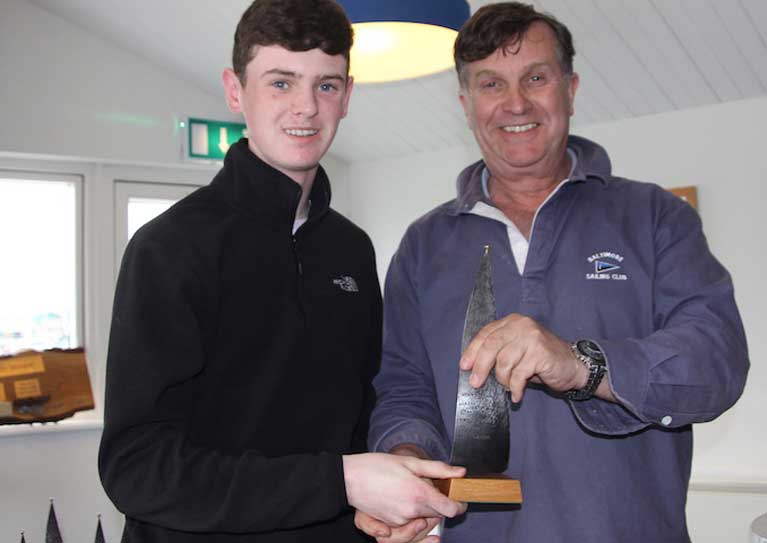 Hugh O'Connor (left) with Baltimore SC Commodore Niall O'Neill
Hugh O'Connor (left) with Baltimore SC Commodore Niall O'Neill
The 4.7 fleet was won by Hugh O’Connor (NYC) at his first 4.7 event having moved from the topper fleet last Autumn. Jonathan O’Shaughnessy (RCYC) secured 2nd place and club teammate Cillian Foster was 3rd with two bullets recorded on Sunday. It was also Cillian’s first Laser event. First Lady and fifth overall was Alana Coakley (RStGYC).
 Radial winner Jamie McMahon
Radial winner Jamie McMahon
The Radial fleet was won by Jamie McMahon (HYC), Rob Keal (RCYC) secured second racing in the radial rig for the first time and Micheal O’Suilleabhain (KYC/RCYC) was third. First Lady and fourth overall was Clare Gorman (NYC). Nine masters raced in this fleet with Sean Craig (RStGYC) securing 1st, Conor Clancy (RStGYC) 2nd and Darrell Reamsbottom (HYC) 3rd master.
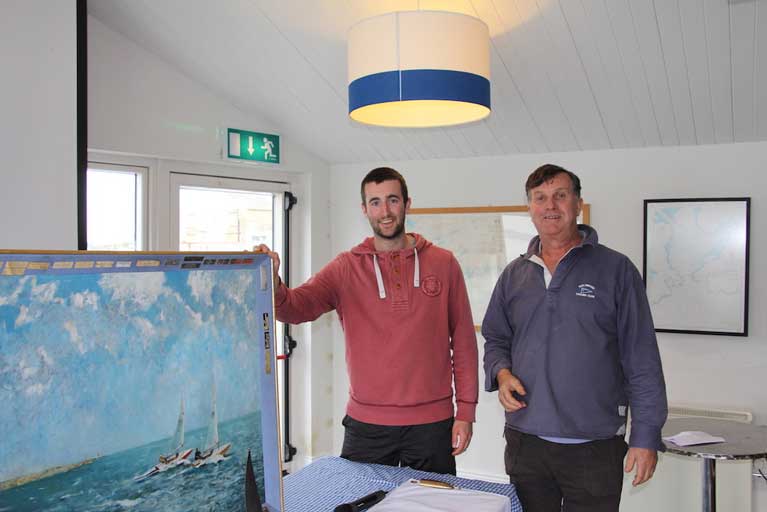 Standard fleet winner Rory Lynch
Standard fleet winner Rory Lynch
It was great to see 26 sailors racing in the Standard Fleet – this fleet was won by Rory Lynch (Blessington/NYC), second overall and first master was Russell McGovern (BYC/RUYC) and third Ronan Wallace (Wexford Harbour Boat & Tennis Club). The second master was Roger O’Gorman (MBSC) and third master – Nick Walsh (RCYC/BSC).
The Baltimore team of volunteers worked their magic again this year to ensure the success of this annual event. Thank you to all who assisted across the various areas – registration, mark laying, committee boat, finish boat, trolley pulling, tally numbers, sandwich making, safety boat cover, results to name just a few of the many jobs!.
Commodore Niall O’Neill presented prizes to the winners at the prizegiving yesterday evening and thanked all the sailors for racing and the Irish Laser Class for hosting the event in Baltimore.
Full Results can be found here.
There was Laser fleet drama for the National Yacht Club's top performing Finn Lynch yesterday when he was disqualified from the second race of the day following a black flag in his 111-boat fleet. So tight are the points at the top of the Laser fleet that even with his super consistency (four results from six in the top ten so far), the race six DSQ result dropped the 22-year-old from third to sixth overall and he is now nine points off the overall lead.
He described his day on the water as 'mixed' (he had an eighth in his first race) but reaching the top ten of this ultra-competitive gold fleet cut is an achievement in itself.
Three races will be attempted today to determine the top-10 boats to sail in the medal race final on Sunday and Lynch will be determined to keep up his medal race participation after top ten finishes twice already this season in Miami and Palma.
The Carlow veteran of the Rio 2016 Olympics had started the day in the top three of his event and posted two top-10 results. However, he was disqualified for early starting in his final race eight, this meant he had to count his earlier worst score, an 18th place. That dropped Lynch to sixth place overall but just four points from the top three ahead of Sunday’s medal race final.
2017 and 2018 Laser World Champion Pavlos Kontides (CYP) is the model of consistency in the 111-boat Laser fleet. The Cypriot is the only competitor that does not hold a double-digit score and it has resulted in him grabbing the lead.
The Laser pack completed their opening series on Friday and will advance to gold and silver fleet racing on Saturday before Sunday’s Medal Race.
Kontides will carry a four-point advantage over Jonatan Vadnai (HUN) in the gold fleet. Hempel World Cup Series Miami gold medallist Hermann Tomasgaard (NOR) is third overall but there is minimal separation at the top of the pack and with three races to follow, anything can happen.
Gold Fleet for Aoife Hopkins
In the Women’s Laser Radial event, after a poor start, Howth Yacht Club’s Aoife Hopkins overtook Aisling Keller in the stakes to qualify for the Gold fleet. Tipperary sailor Keller will now sail in the Silver fleet final series after narrowly missing out by just two points.
Full results are here. Check out all our Irish Olympic sailing coverage in the build-up to Tokyo 2020 here



























